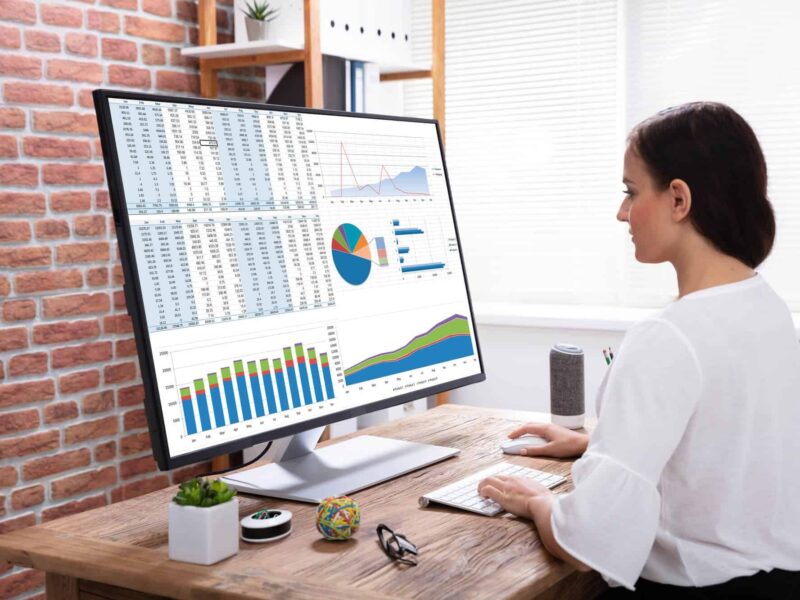At its core, data analytics involves collecting, processing, and analyzing data to conclude. But it is not a one-size-fits-all approach. Data analytics can be categorized into several types:
- Descriptive Analytics: This type focuses on summarizing historical data to understand what has happened. For instance, analyzing last quarter’s sales figures can reveal trends and patterns that inform future strategies.
- Diagnostic Analytics: Here, the goal is to determine why something happened. By exploring relationships between variables organizations can identify the root causes of specific outcomes. For example, if sales dropped, diagnostic analytics can help pinpoint the factors contributing to this decline.
- Predictive Analytics: Using statistical models and machine learning techniques, predictive analytics forecasts future events based on historical data. For example, retailers might analyze customer purchasing behavior to predict what products will be in demand during the holiday season.
- Prescriptive Analytics: This advanced form of analytics not only predicts outcomes but also suggests actions to achieve desired results. For instance, it can help organizations determine optimal pricing strategies based on market trends and consumer behavior.
As you navigate a path in data analytics and visualization, understanding these categories will empower you to choose the right tools and methodologies for your specific needs.
The Role of Data Visualization in Enhancing Analytics
While data analytics provides insights, data visualization brings those insights to life. Imagine trying to understand a complex dataset filled with numbers and jargon. It can be overwhelming, right? That’s where data visualization steps in, turning data into visual formats such as charts, graphs, and dashboards that make information accessible and comprehensible.
Why is Data Visualization Crucial?
- Simplification: Visualization distills complex data into digestible visuals. A well-designed chart can convey more information in seconds than a page of text.
- Patterns and Trends: Visualizations help identify trends, outliers and correlations that may not be immediately apparent in raw data. For example, a line graph can reveal seasonal trends in sales that a table of numbers cannot.
- Engagement: Humans are inherently visual creatures. Engaging visuals can capture attention and make presentations more compelling. Whether you are presenting to stakeholders or sharing insights with your team, effective visuals keep the audience engaged.
- Faster Decision-Making: When data is presented visually, decision-makers can quickly grasp essential insights and act on them. This agility is crucial in today’s fast-paced business environment.
To successfully follow a path in data analytics and visualization, it is essential to master the principles of effective data visualization. Knowing how to choose the right chart type, use colors effectively, and design with clarity in mind can significantly enhance the impact of your insights.
READ ALSO:
How To Utilize Data Analytics to Improve Your Marketing
Benefits of Data Visualization And Why Is a Top Data Skil
Key Tools and Technologies for Data Analytics and Visualization
As you delve deeper into a path in data analytics and visualization, familiarizing yourself with the right tools can streamline your workflow and enhance your analytical capabilities. Here are some of the most popular tools used in the industry:
1. Microsoft Excel
While it may seem basic, Excel remains a powerhouse for data analysis and visualization. Its pivot tables, formulas, and charting capabilities make it a staple for data analysts. Whether you’re conducting simple calculations or creating complex dashboards, Excel is a versatile tool.
2. Tableau
Tableau is a leading data visualization tool that allows users to create interactive and shareable dashboards. Its drag-and-drop interface makes it accessible to users at all skill levels. With Tableau, you can connect to various data sources and generate stunning visuals to present your findings.
3. Power BI
Similar to Tableau, Power BI offers robust data visualization capabilities but integrates seamlessly with other Microsoft products. This tool is ideal for organizations already using Microsoft services, as it provides comprehensive analytics and reporting features.
4. Python and R
For those who prefer programming, Python and R are powerful languages for data analysis and visualization. With libraries such as Matplotlib and Seaborn in Python or ggplot2 in R, you can create intricate visualizations tailored to your needs. This flexibility allows for advanced analysis and customization.
5. Google Data Studio
Google Data Studio is a free tool that enables users to create interactive dashboards and reports from various data sources, including Google Analytics and Google Sheets. Its user-friendly interface makes it a great choice for marketers and small business owners looking to visualize their data effectively.
By equipping yourself with these tools, you can enhance your proficiency on a path in data analytics and visualization, making it easier to transform data into actionable insights.
Building a Strong Foundation in Data Analytics
Before embarking on a path in data analytics and visualization, it is crucial to establish a solid foundation in data analytics principles. Here are some essential steps to consider:
1. Develop a Data-Driven Mindset
Cultivating a data-driven mindset is key to effective analytics. Embrace curiosity and seek to understand the stories that data can tell. Ask questions, challenge assumptions, and use data to validate your decisions.
2. Learn the Basics of Statistics
A fundamental understanding of statistics is vital for analyzing data accurately. Concepts such as mean, median, mode, standard deviation, and correlation are essential for interpreting data and drawing meaningful conclusions.
3. Get Hands-On with Data
Practice is essential in mastering data analytics. Start by working with real datasets available online. Websites like Kaggle offer datasets across various domains, providing an excellent opportunity to practice your analytical skills.
4. Enroll in Online Courses
Numerous online courses and certifications focus on data analytics and visualization. Platforms like Coursera, edX, and Udacity offer courses from top universities and organizations, allowing you to learn at your own pace.
5. Join Data Communities
Engaging with data communities can provide valuable insights and networking opportunities. Platforms like LinkedIn, Reddit, and Meetup host groups focused on data analytics and visualization, where you can learn from others and share your experiences.
Real-World Applications of Data Analytics and Visualization
Understanding the theory is crucial, but seeing how data analytics and visualization apply in the real world is where the magic happens. Numerous industries leverage these skills to enhance their operations and drive growth.
1. Marketing and Sales
In marketing, data analytics helps identify customer preferences, optimize campaigns and measure performance. By visualizing customer data, marketers can tailor their strategies to target specific demographics and improve conversion rates.
For example, a retail company might use data visualization to analyze customer purchase behavior during a holiday season. By identifying trends, the company can tailor promotions to maximize sales.
2. Healthcare
In healthcare, data analytics is revolutionizing patient care. Analyzing patient data can help identify health trends, improve treatment plans, and enhance patient outcomes. Visualization tools allow healthcare professionals to track vital signs and patient histories effectively.
For instance, hospitals use dashboards to monitor patient metrics in real-time, enabling timely interventions and improved patient management.
3. Finance
Financial analysts rely on data analytics to assess investment opportunities, manage risks, and monitor market trends. Visualization tools help present complex financial data in an understandable format, aiding in decision-making.
A financial institution might use predictive analytics to forecast market trends, allowing them to adjust their investment strategies accordingly.
4. Sports Analytics
In sports, data analytics plays a crucial role in player performance evaluation and game strategy development. Coaches and analysts use data to assess player statistics, optimize team performance, and make informed decisions during games.
For instance, basketball teams analyze player shooting percentages and defensive metrics to develop game strategies that enhance their chances of winning.
Challenges in Data Analytics and Visualization
While a path in data analytics and visualization offers immense opportunities, it is not without challenges. Here are some common hurdles professionals face:
1. Data Quality Issues
One of the most significant challenges is ensuring data quality. Inaccurate, incomplete, or inconsistent data can lead to misleading insights. Establishing robust data governance practices is essential to maintaining data integrity.
2. Keeping Up with Rapid Changes
The field of data analytics is continually evolving, with new tools and techniques emerging regularly. Staying current with trends and advancements is crucial to maintaining a competitive edge.
3. Overcoming Resistance to Change
Organizations may resist adopting data-driven practices due to entrenched decision-making processes. Advocating for the value of data analytics and visualization is essential to overcoming this resistance.
4. Communicating Insights Effectively
Even with great insights, if you cannot communicate them effectively, their value diminishes. Developing strong communication skills to present data insights clearly and persuasively is essential.
The Future of Data Analytics and Visualization
As we look ahead, the future of a path in data analytics and visualization appears promising. Here are some trends shaping the industry:
1. Artificial Intelligence and Machine Learning
AI and machine learning are revolutionizing data analytics. These technologies enable organizations to analyze vast amounts of data quickly and accurately, uncovering insights that would be impossible to find manually.
2. Real-Time Analytics
As organizations strive for agility, real-time analytics will become increasingly important. The ability to analyze and visualize data as it is generated will allow businesses to make informed decisions on the fly.
3. Enhanced Data Visualization Tools
Advancements in visualization tools will enable even more interactive and engaging ways to present data. From virtual reality to augmented reality, the future of data visualization promises to captivate audiences and enhance understanding.
4. Data Democratization
The trend toward data democratization is making analytics accessible to non-technical users. User-friendly tools are empowering employees across various departments to leverage data for decision-making.
Embarking on a path in data analytics and visualization is an exciting adventure filled with opportunities for growth and innovation. By understanding the principles of data analytics, mastering visualization techniques, and leveraging the right tools, you can unlock the power of data to drive informed decisions and foster success.







